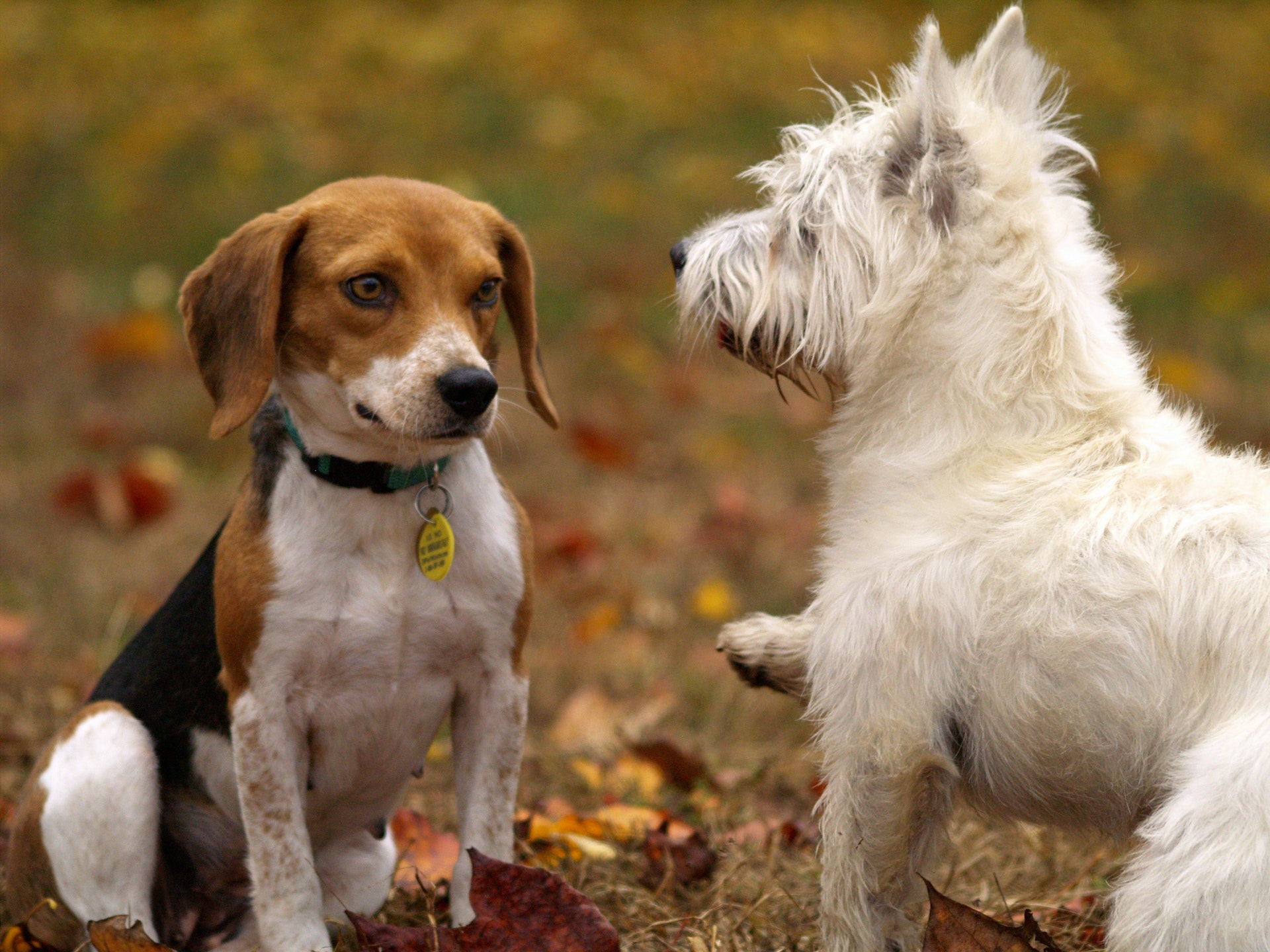Is your dog scared of other dogs? Then asides from walks in the park being no picnic, you’re probably dealing with a lot of questions right now.
Dogs are pack animals, right? So why would a dog suddenly become scared of other members of its pack?
Are all other dogs in the neighborhood secret bullies?
Does it make you a bad owner?
Does it make your dog a freak of nature?
No, no, and no.
None of us, be we dog, cat, human, or something else entirely, are completely fear-free 100% of the time. And neither should we be.
The world can be a big, scary place. If we didn’t feel fear from time to time, we’d run into a lot more trouble than we should. After all, it’s not courage that makes us tiptoe around snakes, look left and right when we cross a road or keep a tight grip on our kid’s hand in busy places. It’s fear.
Basically, fear applied in the right situations, and at the right time, can be a lifesaver.
But when a dog becomes scared of other dogs, we’re looking at something that runs a little deeper than basic survival instinct.
Dogs are everywhere, and by and large, most are completely harmless. Unless you plan on keeping your dog under lock and key for the rest of their life, finding a way to help them deal with their fear is crucial.
Which might seem easier said than done…
If you’ve been dealing with the problem on your own for a while now, you’ve probably tried several different tactics already. By the fact you’re reading this, I’m guessing that none of them have worked out the way you’d hoped.
But don’t give up.
In today’s post, I’ll be discussing the possible reasons for your dog’s fear, and what you can do to overcome it.
Without further ado, let’s get started.
WATCH VIDEO: Discover 5-Step-By-Step Calming Exercises You Can Use RIGHT NOW To Quickly & Permanently Stop Your Dog Being Scared Of Other Dogs…
(video will open in a new window)
How to Recognize Fear in Dogs
Hold up, hold up…
Before we jump the gun by looking at the reasoning behind your dog’s fear, it’s worth taking a second to learn how to recognize that fear in the first place.
Fear isn’t always easy to spot. Sometimes, it can even be mistaken for something else.
A dog barking or lunging at another dog is usually written off as ‘aggressive’. But as often as not, that’s not aggression talking, it’s fear.
Keeping your dog leashed during walks might be the civilized (and right) thing to do, but it has a side effect.
If a fearful dog sees another dog approaching, their flight or fight response kicks in. But with a leash around their neck, their ‘flight’ option is diminished. So, what do they do? You guessed it… fight.
But asides from pulling on the leash and snapping at strangers, what else could suggest your dog is feeling the fear?
In no particular order, common fear symptoms include:
- Exaggerated yawning or excessive lip licking
- Attempting to pull away or turn around to avoid meeting other dogs
- Hiding or cowering
- Shivering or whining
Of course, all dogs are unique. Some might display all of these signs (and maybe even a few more to boot). Others might show just a few.
The good news is that once you’ve recognized the symptoms of fear, you can start tackling it.
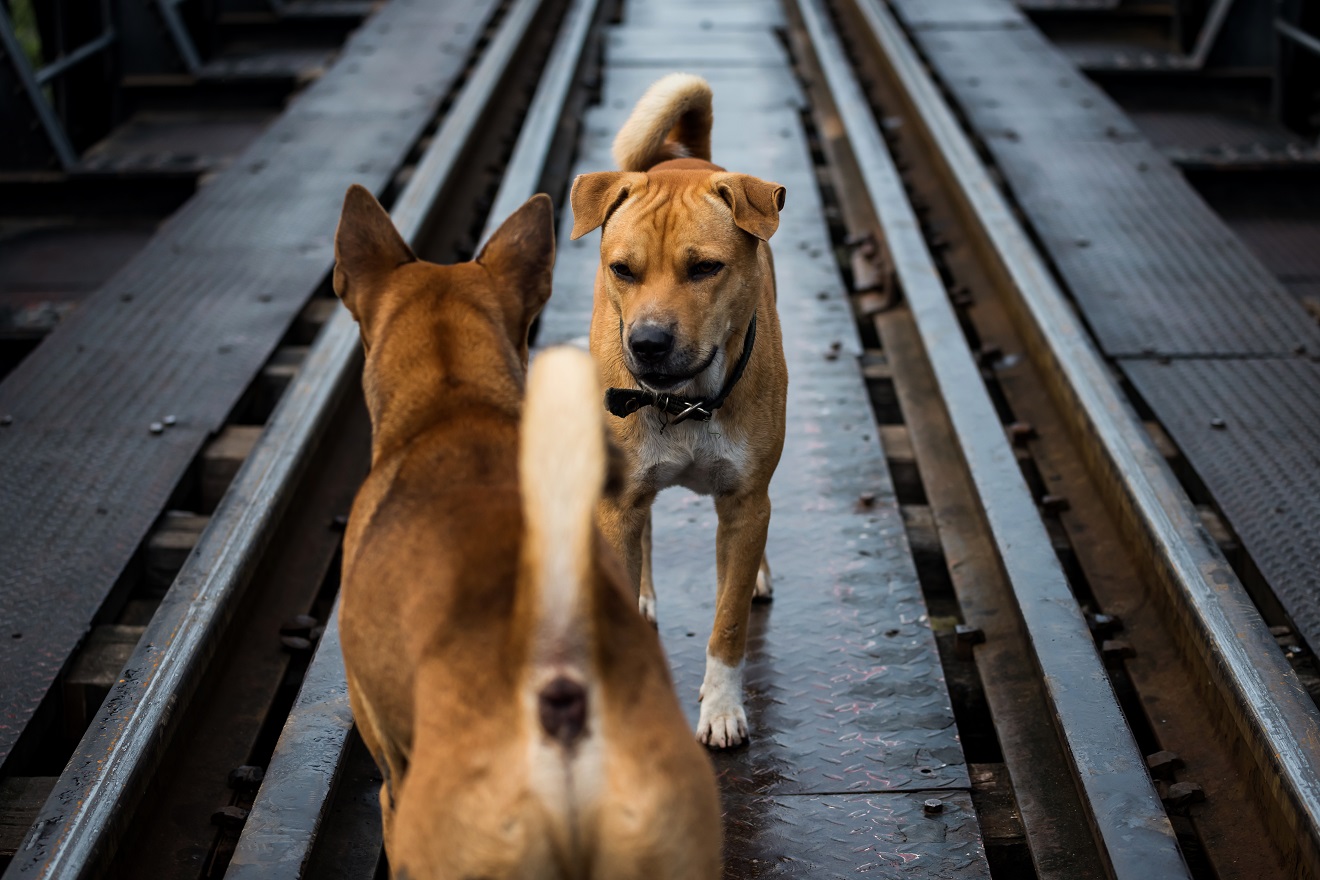
Typical Reasons Your Dog Gets Scared
Make no mistake, the factors behind fear are manifold. Just as no two dogs are guaranteed to show the same signs of fear, no two dogs are guaranteed to feel fear for the same reason.
But hard though it is, understanding the reason for your own dog’s anxiety is the first step towards making positive changes.
Take a look at the following list. Do any of the reasons trigger a lightbulb moment?
It’s in their blood
Some dogs are just genetically more likely to be nervous than others. If their parents were bundles of nerves, they’ve probably inherited the same traits.
Some studies have even suggested that mothers who experience stress during pregnancy release hormones that can have a profound impact on the litter’s chances of developing anxiety.
They were the runts of the litter
If your dog was the smallest and weakest of the litter, being scared and submissive is probably hard-wired into their thinking.
They haven’t been socialized
Number one rule of raising a well-adjusted, happy pooch? Socialize them. Number two rule of raising a well-adjusted, happy pooch? Socialize them some more. Number three rule… well, you get the picture.
Puppies have a small but critical window between the ages of 3 and 16 weeks to be socialized. If they miss out on mixing with other dogs, pets, and people in that period, they’re more likely to develop irrational phobias and fears in later life.
They have generalized anxiety
Some dogs might only feel fear around other dogs. Others experience almost 24/7 anxiety.
Dogs living in a perpetually heightened state of emotion are more likely to have exaggerated reactions to other dogs, especially unfamiliar ones.
Typically, the anxiety will manifest itself in what, to the untrained eye, looks like aggression. To help dogs in this situation, it’s worth checking out these 5 step-by-step calming exercises.
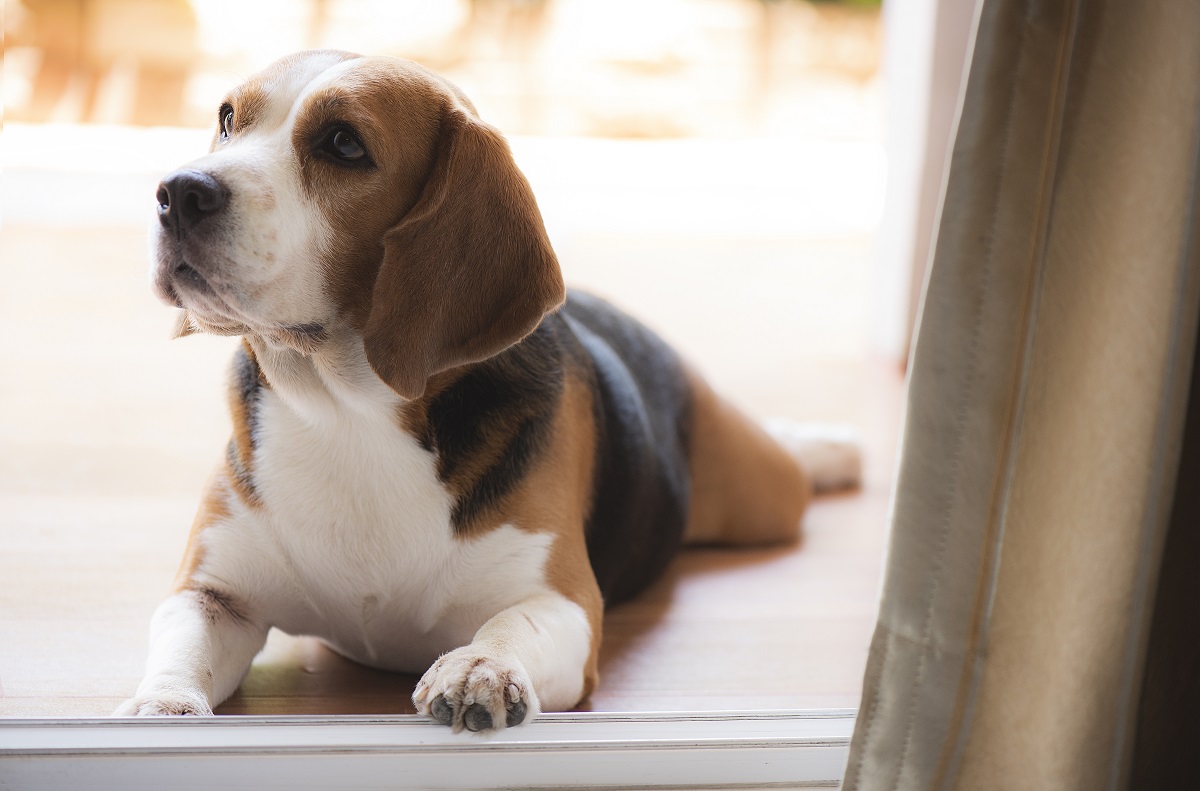
Specific Reasons Your Dog Is Scared Of Other Dogs
So far, we’ve looked at some of the general causes of canine fear. But what if your dog is usually the picture of contentment? What if it’s only when they see other dogs that they become cowering wreaks?
If that’s the case, it could be…
They’re the victim of bad training techniques
Dogs don’t respond well to punishment-based training techniques. But for some reason, that doesn’t stop certain people from using them.
If a dog has ever been the unwilling participant in a training program that utilizes corrective discipline, their fear of other dogs could simply be a delayed response to that training.
Maybe they were punished one too many times for pulling on the leash to greet another dog. If they’ve learned to associate the sight of another dog with something bad happening, it’s no wonder they feel scared.
They have small dog syndrome
If your dog’s happy enough to mix with dogs their own size but kicks up a fuss at the sight of bigger dogs, they could be suffering from ‘small dog syndrome’.
Just like a teenager is scary to a preschooler, an eagle is scary to a robin, and a lion is scary to a pussycat, so a big dog is scary to a little one.
Sometimes, that fear will manifest in submissive behavior. But most of the time, the smaller dog will feel the need to puff up their chest and go on the offensive. It’s not really aggression, of course. But it sure as heck looks like it.
They’re picking up on your fear
Believe it or not, your own fears might be at the root of your dog’s anxieties.
If you’re tense around other dogs (maybe you’ve had one or two bad experiences of your own), it’s likely that tension will travel down the leash in big enough waves for your dog to feel it.
And once they start feeling it, it’s only a matter of time before they start emulating it.
They’ve been attacked in the past
While some dogs are just easily intimated in general, others might have a good reason for their fear.
If your dog has been attacked by another dog in the past, they might have been traumatized enough for a long-lasting phobia to kick in.
If the attack happened during one of their two ‘fear periods’ (i.e., the windows that open between 8-10 weeks and again somewhere between 6-14 months of age when a puppy is more sensitive to stress), that phobia is likely to have taken a vice-like hold by now.
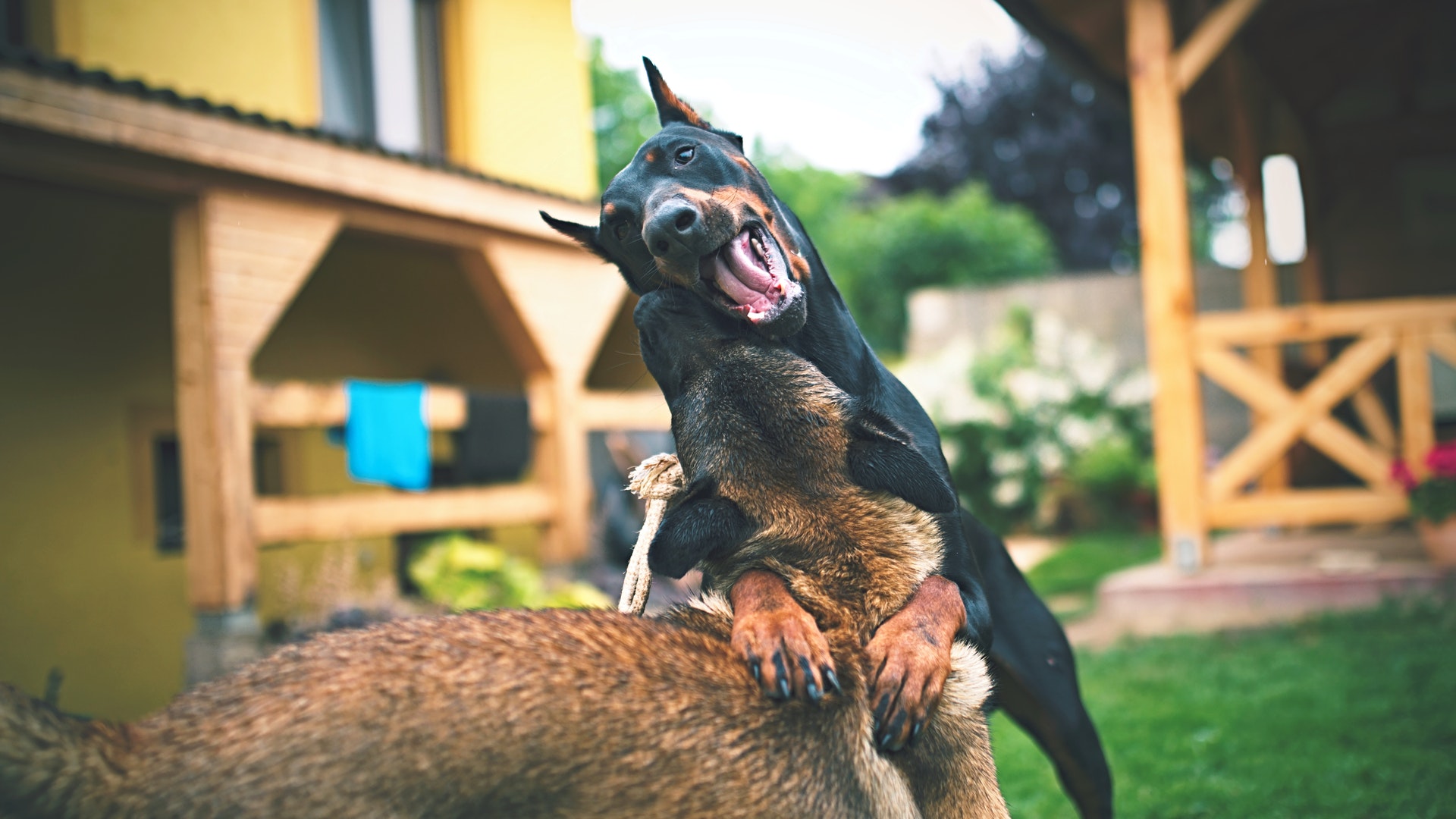
How To Quickly Stop Your Dog Being Scared Of Other Dogs
By now, you’ve probably got a good idea of what’s making your dog scared of other dogs.
But how exactly can you stop it?
The first step? Calm down. It’s unlikely your dog’s fear arose overnight, and it’s even more unlikely it’s going to go away overnight. But that’s ok.
Give yourself some breathing space. While you’re at it, give your dog some, too. This is a process that’s going to take time, energy, and lots of patience.
But you’ll both get there. While you’re on the way, remember to support your dog as much as possible. These 5 step-by-step calming exercises can be used in conjunction with the training, helping to keep your dog calm, focused, and with their eyes firmly on the price.
When it comes to the training itself, I’ve got one word for you – desensitization. Actually, make that two words. Desensitization AND counterconditioning.
Here’s how it works:
1. Work out your dog’s comfort zone
Start by working out exactly how close you can get to another dog before your own pet’s fear response kicks in.
This is going to be different for every dog, and no, there’s no prize for which dog can get the closest.
For some, it’ll be a few feet. Others will start cowering at the merest whiff of an approaching dog. Regardless of what the distance is, make a note of it and don’t try to overstep it during the early stages of the training process.
2. Start counterconditioning
Counterconditioning is just a fancy way of describing the process of replacing a negative reaction with a positive one. In this case, we’re going to use it to stop your dog from seeing other dogs as a ‘bad thing’ and get them to start seeing them as a ‘good thing’.
How do you do this? Simple – appeal to their base instincts.
Whenever you leave the house with your dog, carry a treat dispenser with you. Make sure it’s packed with your dog’s number one favorite treat in the world- this is no time for virtuous but tasteless health food. If you can, reserve these particular treats for walks – if your dog has access to them 24/7, they’re not going to be as effective.
If you see another dog on the outskirts of your dog’s buffer zone, whip the dispenser out and start doling out those treats like you’re going out of business. Keep going until the other dog is well out of sight.
3. Play with their comfort zone
During the first stages of training, it’s vital you respect your dog’s comfort zone. If you start playing fast and loose with their boundaries too soon, you’ll end up doing more harm than good.
But once the counterconditioning starts to work its magic, it’s time to start upping the stakes.
Monitor your dog’s reaction each time another dog approaches the start of their buffer zone. Once they’re able to keep their cool, gradually work on decreasing the threshold, keeping that supply of treats on speed-dial throughout.
Remember – don’t expect to go from 100 feet to 20 in a single day. Slow and steady is the name of the game.
Take your dog’s reactions as your cue. Whenever they get used to a new threshold, decrease it a little bit more. It may take some time, but with perseverance (and plenty of treats), you’ll eventually get to the stage where another dog can pass directly by without a murmur.
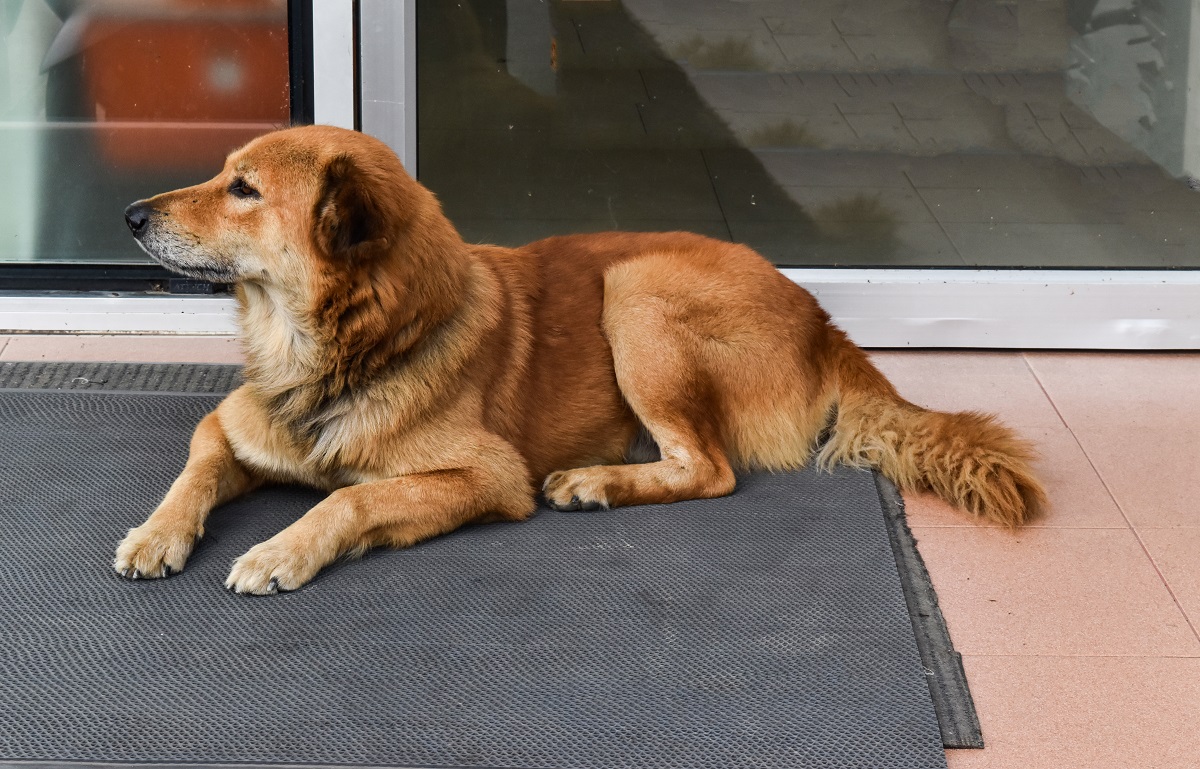
Other Methods to Try
Desensitization and counterconditioning are your Number 1 allies in extreme cases of fear. But if your dog only experiences a mild reaction to other animals, you might want to give the following a try:
Socialize
Make it your mission to take your dog wherever you go. Socialization might work best on pups, but there’s no age limit on learning to overcome shyness or a little bit of mild trepidation.
Speak Up
Like it or not, you’re your pet’s mouthpiece. Some people might think it’s ok to let their own dog approach yours. Let them know it’s not. Equally, if your dog’s fear extends to creatures of the two-legged variety, let people know how best to approach or pet them to minimize their anxiety.
Reward
Don’t force your dog into situations they’re not comfortable with. And never punish them. Negative reinforcement only ever ends one way – badly.
Use plenty of praise and rewards during your training to guarantee the best possible outcome.
Keep Calm
Training can be a long, hard slog. Regardless of how much effort you put in, you’re not going to get there overnight.
To help keep your dog calm and collected while you work on the bigger picture, try incorporating these 5 step-by-step calming exercises into their routine. Remember, practice makes perfect: try to work on them as often as possible for the best results.
Final Thoughts
Your dog might never love playing with other dogs. You know what? Not all dogs do.
Some dogs just don’t find their own kind that interesting. For a start, they’re a lot less handy with the treat dispenser than their human buddies are.
But the aim here isn’t to have a dog that’s straining at the leash to get to doggy daycare. It’s about having a dog that’s confident and free of fear.
It’s not going to be achieved overnight. But stay patient, stay focused, and stay calm, and, trust me, you’ll get there.
You might not have a social butterfly at the end of it, but who wants a butterfly when you could have a happy, well-adjusted dog instead?
WATCH VIDEO: Discover 5-Step-By-Step Calming Exercises You Can Use RIGHT NOW To Quickly & Permanently Stop Your Dog Being Scared Of Other Dogs…
(video will open in a new window)
